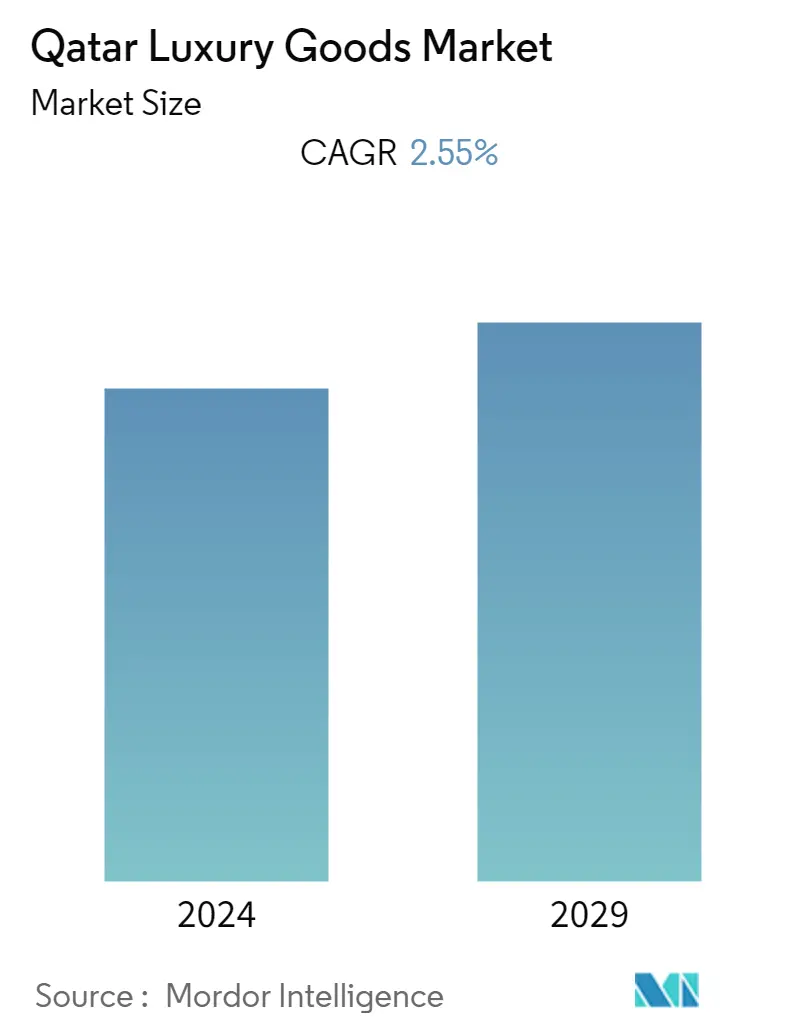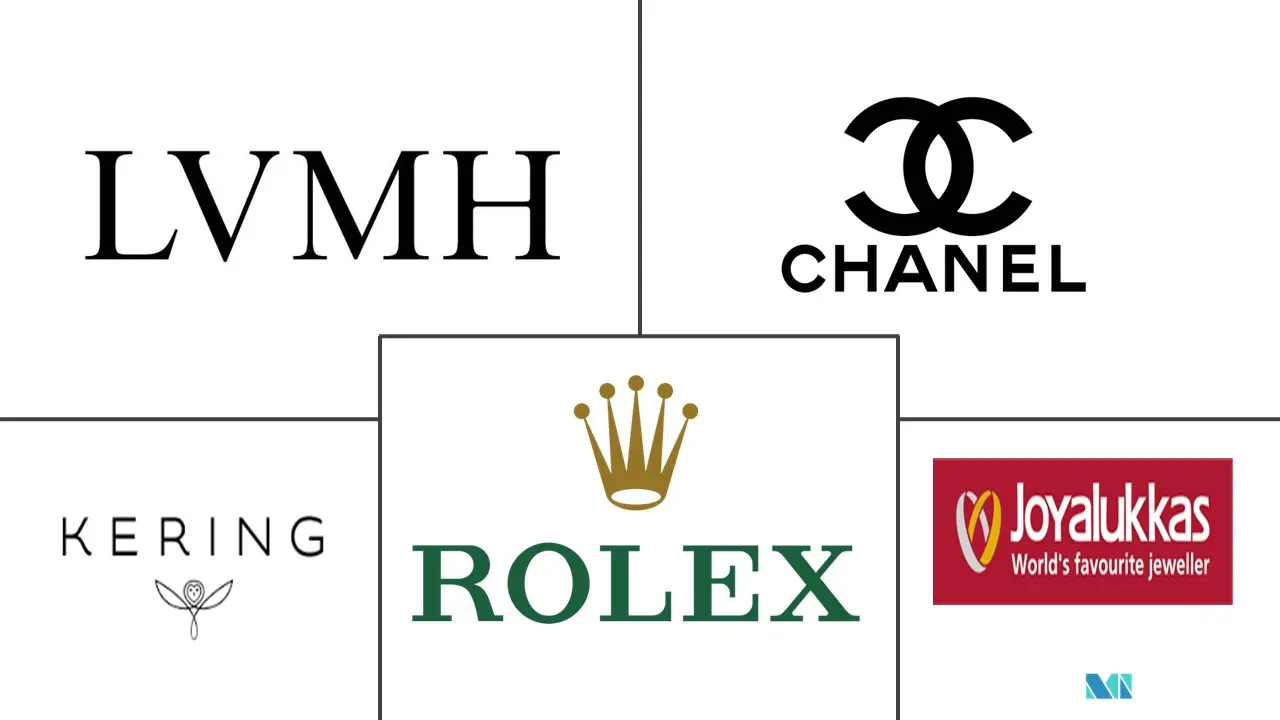Market Size of Qatar Luxury Goods Industry

| Study Period | 2019 - 2029 |
| Base Year For Estimation | 2023 |
| Forecast Data Period | 2024 - 2029 |
| Historical Data Period | 2019 - 2022 |
| CAGR | 2.55 % |
| Market Concentration | Medium |
Major Players
*Disclaimer: Major Players sorted in no particular order |
Luxury Goods Qatar Market Analysis
The Qatari luxury goods market is expected to witness a CAGR of 2.55% during the forecast period.
- Qatar is a rising luxury goods market with prominent fashion brands such as Valentino and landmark department stores including Harrods and Printemps. Qatar is also focusing on developing its own luxury label named Qela.
- However, with the impact of COVID-19, the closed stores in tandem with limited shopping timings led the market to change its scenario, allowing online stores to grab the opportunity. Also, consumers in Qatar are considered the biggest buyers of goods in the Middle East, and the luxury goods industry is poised for the huge potential for growth in coming years.
- The rising Internet penetration has provided consumers with easy access to information about products, and they can easily compare the prices of different products. Furthermore, consumer preferences are changing, wherein more demand is placed on innovative jewelry designs, supporting market demand and growth for luxury goods in the Qatar market over the forecast years.
- However, factors such as pricing fluctuations, inflation rates, and political uncertainties in Qatar are expected to hinder market growth over the forecast period.
Luxury Goods Qatar Industry Segmentation
Luxury goods are those goods that are highly desired and are associated with the status symbol of wealthy and affluent people.
The demand for such goods increases more than what is proportional as income rises, so expenditures on the goods become a greater proportion of overall spending. The Qatar luxury goods market is segmented by type, distribution channel, and gender. Based on type, the market is segmented into clothing and apparel, footwear, bags, jewelry, watches, and other accessories. Based on the distribution channel, the market is segmented into single-brand stores, multi-brand stores, online stores, and other distribution channels. Based on gender, the market is segmented into males and females.
The market sizing and forecasts have been done based on USD million value for each segment.
| By Type | |
| Clothing and Apparel | |
| Footwear | |
| Bags | |
| Jewellery | |
| Watches | |
| Other Accessories |
| By Distribution Channel | |
| Single Brand Stores | |
| Multi Brand Stores | |
| Online Stores | |
| Other Distribution Channels |
| By Gender | |
| Male | |
| Female |
Qatar Luxury Goods Market Size Summary
The luxury goods market in Qatar is experiencing a notable transformation, driven by a combination of factors such as rising consumer demand, urbanization, and increased disposable income. The presence of high-end fashion brands like Valentino and the establishment of luxury department stores such as Harrods and Printemps underscore Qatar's emergence as a significant luxury fashion hub in the Middle East. The market is further bolstered by the introduction of local luxury labels like Qela and the expansion of international retailers, which are capitalizing on the affluent consumer base. The shift towards online shopping, accelerated by the COVID-19 pandemic, has also opened new avenues for growth, with consumers increasingly seeking innovative and unique luxury products, particularly in jewelry. However, challenges such as pricing fluctuations, inflation, and political uncertainties may pose obstacles to sustained market expansion.
The Qatari luxury goods market is characterized by a moderately fragmented landscape, with a mix of international and local players contributing to its growth. The expansion of organized retail spaces, including major projects like Place Vendome, which offers a comprehensive shopping and entertainment experience, is attracting more luxury brands to the region. Mono-brand stores from renowned international labels are becoming prominent, catering to quality-oriented consumers. The market's growth is supported by technological advancements in product design and the strategic use of e-commerce platforms, such as the launch of Ounass, which offers a wide range of luxury products online. As the market continues to evolve, the presence of key players like Chanel, LVMH, and Rolex, along with ongoing investments in retail infrastructure, is expected to drive further growth in the coming years.
Qatar Luxury Goods Market Size - Table of Contents
-
1. MARKET INSIGHTS
-
1.1 Market Drivers
-
1.2 Market Restrains
-
1.3 Industry Attractiveness - Porter's Five Forces Analysis
-
1.3.1 Bargaining Power of Suppliers
-
1.3.2 Bargaining Power of Buyers
-
1.3.3 Threat of New Entrants
-
1.3.4 Threat of Substitute Products/Services
-
1.3.5 Intensity of Competitive Rivalry
-
-
-
2. MARKET SEGMENTATION
-
2.1 By Type
-
2.1.1 Clothing and Apparel
-
2.1.2 Footwear
-
2.1.3 Bags
-
2.1.4 Jewellery
-
2.1.5 Watches
-
2.1.6 Other Accessories
-
-
2.2 By Distribution Channel
-
2.2.1 Single Brand Stores
-
2.2.2 Multi Brand Stores
-
2.2.3 Online Stores
-
2.2.4 Other Distribution Channels
-
-
2.3 By Gender
-
2.3.1 Male
-
2.3.2 Female
-
-
Qatar Luxury Goods Market Size FAQs
What is the current Qatar Luxury Goods Market size?
The Qatar Luxury Goods Market is projected to register a CAGR of 2.55% during the forecast period (2024-2029)
Who are the key players in Qatar Luxury Goods Market?
Chanel, LVMH, Rolex, Kering and Joyalukkas are the major companies operating in the Qatar Luxury Goods Market.

